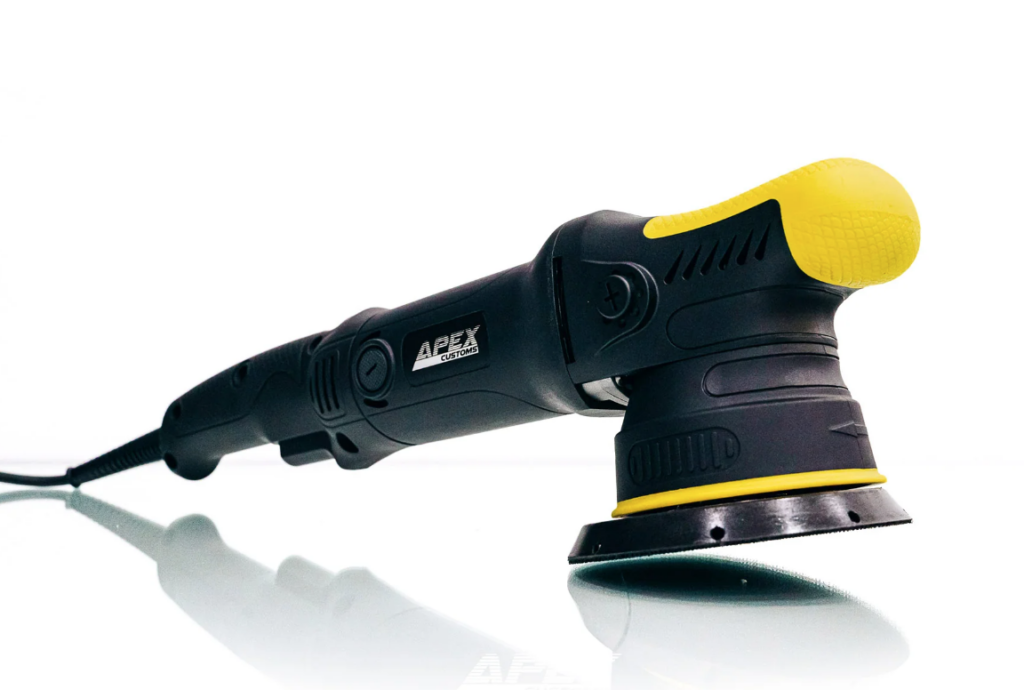If you are an intermediate detailer in Australia striving to optimise your polishing technique, understanding the nuances between rotary and dual action polishers is crucial.
These machines, although used to achieve similar goals, operate quite differently.
In this blog post, we will delve deeper into the specifics of each type and assist you in making an informed choice.
Introduction
Polishing is a significant step in maintaining the aesthetic and health of your car’s paintwork. Utilising the right machine polisher can not only enhance the appearance of your car but also prolong the life of the paint.
This post aims to provide you with an in-depth understanding of rotary and dual action polishers, helping you to hone your skills further.
Understanding the Basics
Before we dive into the complexities, it’s essential to grasp the basics of these machines:
Rotary Polishers

- Operation: Operates in a continuous circular motion, enabling efficient and fast correction.
- Skill Level: High – best suited for professionals or experienced detailers.
- Pros: Offers more power, enabling faster correction.
- Cons: Has a higher risk of causing paint damage, demands more skill and experience.
Dual Action Polishers

- Operation: Combines spinning and jiggling motions in a random oscillating manner, making it safer on the paint.
- Skill Level: Low to intermediate – A great choice for beginners and enthusiasts.
- Pros: Lower risk of paint damage, easier to handle for newcomers.
- Cons: Less aggressive and might take a bit longer for paint correction.
Detailed Comparison
To give you a more comprehensive insight, let’s breakdown the detailed comparison of these polishers in a tabular format:
Rotary Polishers vs. Dual Action Polishers
| Aspect | Rotary Polishers | Dual Action Polishers |
| Nature of Operation | Operates in a circular motion, rotating continuously | Operates in a random, oscillating manner, combining both spinning and jiggling motions |
| Skill Level Required | High (Best suited for experienced detailers) | Intermediate to Low (Suitable for beginners and enthusiasts) |
| Pros | • Faster Correction • More Power |
• Safer for Paint • Easier for Beginners to Use |
| Cons | • Higher Risk of Paint Damage • Requires More Skill and Experience |
• Might Take Longer for Paint Correction • Less Aggressive |
| Best Scenarios for Use | • Deep Scratch and Swirl Mark Removal • Utilized by Experienced Detailers Seeking Swift Results |
• Light to Moderate Paint Correction • Utilized by Beginners or Enthusiasts Seeking a Safer Option |
| Safety for the Paint | Relatively Lower | Relatively Higher |
Tips for Utilising These Polishers
While both machines offer unique advantages, the choice depends largely on your skill level and the specific detailing scenario. Here are a few expert tips to get the best out of each type:
- Rotary Polishers
- For Experienced Detailers: Given the power and efficiency of rotary polishers, experienced detailers can achieve swift and stunning results.
- Adopt a Gradual Approach: Start with a less aggressive pad and compound combination and gradually move to more aggressive combinations as needed.
- Dual Action Polishers
- Ideal for Beginners: Since dual action polishers are less aggressive, they are a safer option for beginners.
- Perfect for Regular Maintenance: These are ideal for regular maintenance detailing, helping to maintain the shine and lustre without risking paint damage.
Choosing the Right Polisher
Selecting the right polisher for your detailing venture is a crucial decision that influences the quality of the final outcome. While both rotary and dual-action polishers have their merits, your choice hinges on several determinants such as your proficiency, the existing condition of the car’s paint, and the envisioned results.
Below, we delineate a step-by-step guideline to steer you towards an informed selection:
- Assess the Condition of Your Car’s Paint
- Visual Inspection: Begin with a thorough visual inspection of the vehicle’s paintwork to gauge the extent of the damages and imperfections present. Take note of swirl marks, scratches, or oxidations that mar the surface.
- Detailing Goals: Set clear detailing objectives, whether it’s merely revitalising the car’s shine or a more intensive correction process to eradicate deep-seated blemishes.
- Consider Your Skill Level and Experience
- Beginner: If you are a beginner, steering towards a dual-action polisher might be prudent owing to its user-friendly nature and lesser risk of inflicting paint damage.
- Experienced: For the seasoned detailer, a rotary polisher could be the tool of choice, capable of achieving swift and remarkable results, albeit requiring a steeper learning curve and adept handling.
- Weigh the Pros and Cons
- Individual Comfort Level: Your comfort level with the machine is paramount. Choose a polisher that aligns with your skill set, allowing for a seamless and efficient polishing process.
- Project Specifications: Consider the specific demands of your detailing project. Sometimes, a combination of both types of polishers might be necessary to attain the desired finish, utilizing the strengths of each to complement the other.
Tips for Effective Polishing
Irrespective of the polisher you elect to use, adhering to proper techniques and preparation procedures can profoundly influence the success of your polishing project. Below are some expert insights to facilitate a stellar polishing job:
- Preparation Steps
- Cleaning: Prioritise cleaning the vehicle thoroughly to remove dirt, grime, and other contaminants that could interfere with the polishing process.
- Decontamination: Before embarking on the polishing, ensure that the paint surface is devoid of contaminants through processes like clay barring, which prepares the paintwork for a smoother polishing experience.
- Masking: Mask off sensitive areas such as plastic trims and rubber seals to prevent them from getting marred during the polishing process.
- Techniques
- Uniform Pressure: Maintain a consistent pressure throughout the process to prevent undue stress on any particular section of the paint, which could lead to burns or holograms. Let the weight of the polisher do the work for you, using your hands as a guide.
- Overlapping Passes: Employ a technique of making overlapping passes, ensuring that each section receives equal attention, thereby avoiding uneven results and promoting a smooth, glossy finish.
- Appropriate Compounds and Pads: The choice of compounds and pads is vital. Select products that are compatible with the nature of your polisher and the paint condition, enabling an effective and safe correction process.
- Temperature Management: Be mindful of the temperature of the paint surface to prevent overheating, which can cause paint warping or burning. Regularly check the temperature and allow cool-down periods as necessary.
Conclusion
In conclusion, the choice between rotary and dual action largely depends on your expertise level and the specific needs of your vehicle’s paint correction process.
With this guide in hand, you are now better equipped to make a choice that matches your skill level and the detailing requirements of your vehicle.
Remember, the ultimate goal is to enhance the beauty and longevity of your car’s paint, and choosing the right tool is a step in the right direction.
Frequently Asked Questions (FAQs)
If you are starting, a dual action polisher is recommended due to its safety features and ease of handling. As you grow more experienced, you can then experiment with rotary polishers.
Yes, rotary polishers, due to their continuous circular motion, can cause paint burns or swirl marks if not used carefully and skillfully. It is advised to gain some experience or seek professional training before using rotary polishers.
Both types of polishers require regular maintenance to ensure their longevity. This includes cleaning the pads thoroughly after each use and storing the machine in a dust-free environment.
Absolutely, experienced detailers often use both types of polishers in tandem to achieve the best results. For instance, a rotary can be used for heavy correction work, followed by a dual action polisher for finishing.
The choice of pads and compounds largely depends on the specific requirements of your detailing project. Generally, heavier compounds are used with rotary polishers for deep correction, while lighter compounds are reserved for dual action polishers for a finer finish.
The price can vary based on various factors including brand, features, and specifications. However, generally, rotary polishers can be a bit more expensive given their power and professional-grade capabilities.
-

Calvin brings a wealth of experience across multiple engineering disciplines, including chemical, mechanical, and electrical engineering. His in-depth knowledge of filtration systems and hydraulic pumps has positioned him as an expert in the pressure washer product category. With a unique combination of technical expertise and business insight, Calvin excels at solving complex challenges and driving innovation, particularly in the car detailing industry.
-

Aaron is a passionate car detailing enthusiast who channels his expertise and love for pristine vehicles into engaging blog content for a leading detail store website. With a keen eye for detail and a wealth of knowledge about the latest products and techniques, Aaron provides invaluable insights and tips to fellow car enthusiasts. His dedication to achieving showroom-quality results and his ability to explain complex processes in an easy-to-understand manner make his blog a go-to resource for anyone looking to elevate their car detailing game.

